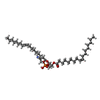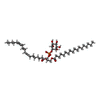+ Open data
Open data
- Basic information
Basic information
| Entry | Database: PDB / ID: 7she | |||||||||
|---|---|---|---|---|---|---|---|---|---|---|
| Title | Cryo-EM structure of human GPR158 | |||||||||
 Components Components | G-protein coupled receptor 158 | |||||||||
 Keywords Keywords | SIGNALING PROTEIN / Receptor | |||||||||
| Function / homology |  Function and homology information Function and homology informationG protein-coupled glycine receptor activity / regulation of G protein-coupled receptor signaling pathway / positive regulation of neurotransmitter secretion / regulation of synapse organization / protein localization to plasma membrane / cell projection / enzyme activator activity / postsynaptic density membrane / brain development / cognition ...G protein-coupled glycine receptor activity / regulation of G protein-coupled receptor signaling pathway / positive regulation of neurotransmitter secretion / regulation of synapse organization / protein localization to plasma membrane / cell projection / enzyme activator activity / postsynaptic density membrane / brain development / cognition / transmembrane signaling receptor activity / presynaptic membrane / postsynaptic membrane / G protein-coupled receptor signaling pathway / nucleus / plasma membrane Similarity search - Function | |||||||||
| Biological species |  Homo sapiens (human) Homo sapiens (human) | |||||||||
| Method | ELECTRON MICROSCOPY / single particle reconstruction / cryo EM / Resolution: 3.4 Å | |||||||||
 Authors Authors | Patil, D.N. / Singh, S. / Singh, A.K. / Martemyanov, K.A. | |||||||||
| Funding support |  United States, 1items United States, 1items
| |||||||||
 Citation Citation |  Journal: Science / Year: 2022 Journal: Science / Year: 2022Title: Cryo-EM structure of human GPR158 receptor coupled to the RGS7-Gβ5 signaling complex. Authors: Dipak N Patil / Shikha Singh / Thibaut Laboute / Timothy S Strutzenberg / Xingyu Qiu / Di Wu / Scott J Novick / Carol V Robinson / Patrick R Griffin / John F Hunt / Tina Izard / Appu K Singh ...Authors: Dipak N Patil / Shikha Singh / Thibaut Laboute / Timothy S Strutzenberg / Xingyu Qiu / Di Wu / Scott J Novick / Carol V Robinson / Patrick R Griffin / John F Hunt / Tina Izard / Appu K Singh / Kirill A Martemyanov /    Abstract: GPR158 is an orphan G protein–coupled receptor (GPCR) highly expressed in the brain, where it controls synapse formation and function. GPR158 has also been implicated in depression, carcinogenesis, ...GPR158 is an orphan G protein–coupled receptor (GPCR) highly expressed in the brain, where it controls synapse formation and function. GPR158 has also been implicated in depression, carcinogenesis, and cognition. However, the structural organization and signaling mechanisms of GPR158 are largely unknown. We used single-particle cryo–electron microscopy (cryo-EM) to determine the structures of human GPR158 alone and bound to an RGS signaling complex. The structures reveal a homodimeric organization stabilized by a pair of phospholipids and the presence of an extracellular Cache domain, an unusual ligand-binding domain in GPCRs. We further demonstrate the structural basis of GPR158 coupling to RGS7-Gβ5. Together, these results provide insights into the unusual biology of orphan receptors and the formation of GPCR-RGS complexes. | |||||||||
| History |
|
- Structure visualization
Structure visualization
| Movie |
 Movie viewer Movie viewer |
|---|---|
| Structure viewer | Molecule:  Molmil Molmil Jmol/JSmol Jmol/JSmol |
- Downloads & links
Downloads & links
- Download
Download
| PDBx/mmCIF format |  7she.cif.gz 7she.cif.gz | 211.8 KB | Display |  PDBx/mmCIF format PDBx/mmCIF format |
|---|---|---|---|---|
| PDB format |  pdb7she.ent.gz pdb7she.ent.gz | 176.2 KB | Display |  PDB format PDB format |
| PDBx/mmJSON format |  7she.json.gz 7she.json.gz | Tree view |  PDBx/mmJSON format PDBx/mmJSON format | |
| Others |  Other downloads Other downloads |
-Validation report
| Summary document |  7she_validation.pdf.gz 7she_validation.pdf.gz | 1.7 MB | Display |  wwPDB validaton report wwPDB validaton report |
|---|---|---|---|---|
| Full document |  7she_full_validation.pdf.gz 7she_full_validation.pdf.gz | 1.7 MB | Display | |
| Data in XML |  7she_validation.xml.gz 7she_validation.xml.gz | 47.3 KB | Display | |
| Data in CIF |  7she_validation.cif.gz 7she_validation.cif.gz | 65.1 KB | Display | |
| Arichive directory |  https://data.pdbj.org/pub/pdb/validation_reports/sh/7she https://data.pdbj.org/pub/pdb/validation_reports/sh/7she ftp://data.pdbj.org/pub/pdb/validation_reports/sh/7she ftp://data.pdbj.org/pub/pdb/validation_reports/sh/7she | HTTPS FTP |
-Related structure data
| Related structure data |  25125MC  7shfC M: map data used to model this data C: citing same article ( |
|---|---|
| Similar structure data |
- Links
Links
- Assembly
Assembly
| Deposited unit | 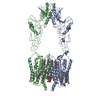
|
|---|---|
| 1 |
|
- Components
Components
| #1: Protein | Mass: 88251.633 Da / Num. of mol.: 2 Source method: isolated from a genetically manipulated source Source: (gene. exp.)  Homo sapiens (human) / Gene: GPR158, KIAA1136 / Production host: Homo sapiens (human) / Gene: GPR158, KIAA1136 / Production host:  Homo sapiens (human) / References: UniProt: Q5T848 Homo sapiens (human) / References: UniProt: Q5T848#2: Chemical | ChemComp-PEE / | #3: Chemical | ChemComp-EIJ / ( | #4: Chemical | ChemComp-CLR / Has ligand of interest | Y | |
|---|
-Experimental details
-Experiment
| Experiment | Method: ELECTRON MICROSCOPY |
|---|---|
| EM experiment | Aggregation state: PARTICLE / 3D reconstruction method: single particle reconstruction |
- Sample preparation
Sample preparation
| Component | Name: Receptor / Type: COMPLEX / Entity ID: #1 / Source: RECOMBINANT |
|---|---|
| Molecular weight | Value: 0.170 MDa / Experimental value: NO |
| Source (natural) | Organism:  Homo sapiens (human) Homo sapiens (human) |
| Source (recombinant) | Organism:  Homo sapiens (human) Homo sapiens (human) |
| Buffer solution | pH: 8 |
| Specimen | Conc.: 0.3 mg/ml / Embedding applied: NO / Shadowing applied: NO / Staining applied: NO / Vitrification applied: YES |
| Vitrification | Instrument: FEI VITROBOT MARK IV / Cryogen name: ETHANE / Humidity: 100 % / Chamber temperature: 277 K |
- Electron microscopy imaging
Electron microscopy imaging
| Experimental equipment |  Model: Titan Krios / Image courtesy: FEI Company |
|---|---|
| Microscopy | Model: TFS KRIOS |
| Electron gun | Electron source:  FIELD EMISSION GUN / Accelerating voltage: 300 kV / Illumination mode: OTHER FIELD EMISSION GUN / Accelerating voltage: 300 kV / Illumination mode: OTHER |
| Electron lens | Mode: OTHER / Nominal defocus max: 2500 nm / Nominal defocus min: 1500 nm |
| Image recording | Electron dose: 40 e/Å2 / Film or detector model: GATAN K3 (6k x 4k) |
- Processing
Processing
| EM software | Name: cryoSPARC / Version: 3.1 / Category: 3D reconstruction |
|---|---|
| CTF correction | Type: PHASE FLIPPING AND AMPLITUDE CORRECTION |
| Particle selection | Num. of particles selected: 4374550 |
| Symmetry | Point symmetry: C1 (asymmetric) |
| 3D reconstruction | Resolution: 3.4 Å / Resolution method: FSC 0.143 CUT-OFF / Num. of particles: 263237 / Symmetry type: POINT |
| Atomic model building | Protocol: AB INITIO MODEL / Space: REAL |
 Movie
Movie Controller
Controller




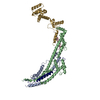

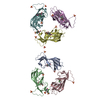
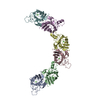
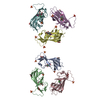
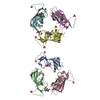
 PDBj
PDBj






